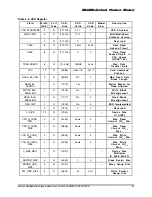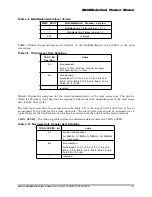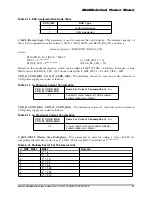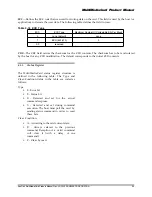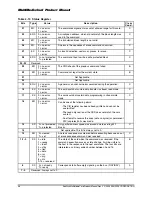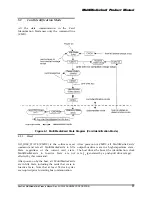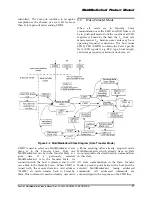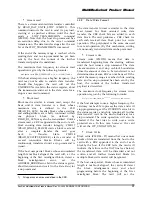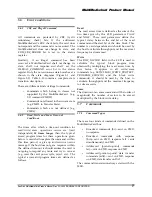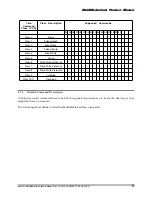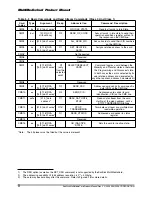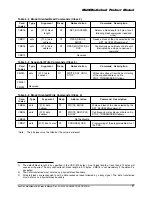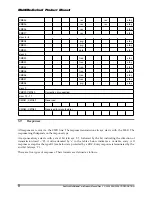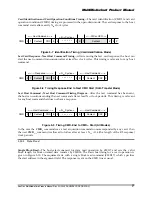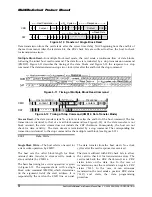
MultiMediaCard Product Manual
SanDisk MultiMediaCard Product Manual Rev. 2 © 2000 SANDISK CORPORATION
43
•
Stream read
There is a stream oriented data transfer controlled
by READ_DAT_UNTIL_STOP (CMD11). This
command instructs the card to send its payload,
starting at a specified address, until the host
sends a STOP_TRANSMISSION
command
(CMD12). Note that the host stop command has
an execution delay due to the serial command
transmission. The data transfer stops after the end
bit of the STOP_TRANSMISSION command.
If the end of the memory range is reached while
sending data and no stop command has yet been
sent by the host, the content of the further
transferred payload is undefined.
The maximum clock frequency for stream read
operation is given by the following formula:
max. speed = min (TRAN_SPEED, (8*2
READ_BL_LEN
– NSAC)/TAAC)
1
If the host attempts to use a higher frequency, the
card may not be able to sustain data transfer.
Should this happen, the card will set the
UNDERRUN error bit in the status register, abort
the transmission and wait in the data state for a
stop or a new read command.
•
Block read
Block read is similar to stream read, except the
basic unit of data transfer is a block whose
maximum
size is defined in the CSD
(READ_BL_LEN). Smaller blocks whose starting
and ending address are wholly contained within
one
physical
block
(as defined by
READ_BL_LEN) may also be transmitted. Unlike
stream read, a CRC is appended to the end of each
block ensuring data transfer integrity. CMD17
(READ_SINGLE_BLOCK) starts a block read and
after a complete transfer the
card goes
back to Transfer State.
CMD18
(READ_MULTIPLE_BLOCK) starts a transfer of
several consecutive blocks. Blocks will be
continuously transferred until a stop command is
issued.
If the host uses partial blocks whose accumulated
length is not block aligned, the card will, at the
beginning of the first misaligned block, detect a
block
misalignment error, set the
ADDRESS_ERROR error bit in the status register,
abort transmission and wait (in the
Data State
) for
a stop command.
1)
All upper case names are defined in the CSD.
5.3.2
Data Write Format
The data transfer format is similar to the data
read format. For block oriented write data
transfer, the CRC check bits are added to each
data block. The card performs a CRC check for
each such received data block prior to a write
operation. (The polynomial is the same one used
for a read operation.) By this mechanism, writing
of erroneously transferred data can be prevented.
•
Stream write
Stream write (CMD20) means that data is
transferred beginning from the starting address
until the host issues a stop command. The data
stream must start and stop on block boundaries.
Since the amount of data to be transferred is not
determined in advance, CRC can not be used. If the
end of the memory range is reached while sending
data and no stop command has been sent by the
host, the content of the further transferred
payload is discarded.
The maximum clock frequency for stream write
operation is given by the following formula:
max. speed = min (TRAN_SPEED, (8*2
WRITE_BL_LEN
– NSAC)/(TAAC*R2W_FACTOR))
If the host attempts to use a higher frequency, the
card may not be able to process the data and will
stop programming, set the OVERRUN error bit in
the status register, and while ignoring all further
data transfer, wait (in the
Receive-Data-State
) for a
stop command. The write operation will also be
aborted if the host tries to write over a write
protected area. In this case, however, the card
will set the WP_VIOLATION bit.
•
Block Write
Block write (CMD24 - 27) means that one or more
blocks of data are transferred from the host to the
card with a CRC appended to the end of each
block by the host. If the CRC fails, the card will
indicate the failure on the DAT line (see below);
the transferred data will be discarded and not
written and all further transmitted blocks (in
multiple block write mode) will be ignored.
If the host uses partial blocks whose accumulated
length is not block aligned, the card will detect
the
block
misalignment
error and abort
programming before the beginning of the first
misaligned block. The card will set the

